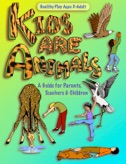Movement can and should be an integral part of the school day, and not just at recess..
It just makes sense:
-
1.Children are suffering preventable diseases associated with a sedentary lifestyle.
-
2.Absenteeism due to illness impacts academic success.
-
3.Exercise aids learning.
Free Resources
The following options will be made available to public and private schools and daycares:
-
• All teachers and schools are offered the free e-book download.
-
• School districts may post the On-line and E-book versions of “AEF” on their web sites.
-
• Grant opportunities will be pursued.
Please download a copy of the E-book to review.
click here Kids Are Animals E-Book.pdf.
Classroom Editions
Various resources will be developed for the classroom including:
-
• Big book formats
-
• Posters
-
• Lesson plans
-
• Classroom safety guidelines
Educational Outreach
There are over 600,000 Preschool and kindergarten teachers in the United States. Learning through play is an integral part of the curriculum. “Kids Are Animals” is ideally suited for the playground, and easily adapted to the classroom.
Fundraising
Branded publication rights for fundraising will also be available at a minimal cost.
Sponsorship
We encourage organizations to seek out corporations and organizations wishing to fund the “Animals for All” program.
Grants
We will establish support for “Animals for All” through federal, state and private grants.
Join Our Advisory Review Board
Is child development your passion? Please add to our Cross-disciplinary peer review. more info . . .
Educational Statistics
Preschool and kindergarten teachers: 607,000
Preschool teachers: 437,000
Kindergarten teachers: 170,000
First Grade teachers: 250,000
Pre-K Enrollment
Enrollment of 3- to 5-year-olds in pre-kindergarten and kindergarten programs:
Level
Prekindergarten: 4,569,000
Kindergarten: 3,488,000
Total 8,056,000
Percent enrolled: 65%
Public: 5,619,000
Private: 2,437,000
Enrollment in public elementary schools: fall 2008 - 34,903,000
Enrollment in private elementary schools: fall 2008 - 4,681,000 (prekindergarten through 8)
54% - Percentage of 3- and 4-year-olds enrolled in school. <http://www.census.gov/population/www/socdemo/school.html>
68% - Percentage of children enrolled in kindergarten who attend all day. <http://www.census.gov/population/www/socdemo/school.html>
How Many Schools? 95,615
Number of public elementary and secondary schools. The corresponding number of private elementary and secondary schools is 29,273. <http://www.census.gov/prod/www/statistical-abstract.html>
Number of students who are homeschooled. 1.1 million
That is 2 percent of all students ages 5 to 17.
<http://www.census.gov/prod/www/statistical-abstract.html>
Languages - 10 million school-age children (5 to 17) speak a language other than English at home. These children make up nearly 1-in-5 in this age group. Most of them (7.1 million) speak Spanish at home. (Source: American FactFinder)
Government Spending on Education - $8,287
The per-pupil expenditure on elementary and secondary education nationally in 2004. New Jersey ($12,981) spent the most among states or state-equivalents, followed by New York ($12,930), the District of Columbia ($12,801), Vermont ($11,128) and Connecticut ($10,788). Utah ($5,008) spent the least per student, followed by Idaho ($6,028), Arizona ($6,036), Oklahoma ($6,176) and Mississippi ($6,237). <http://www.census.gov/Press-Release/www/releases/archives/economic_surveys/006685.html>



